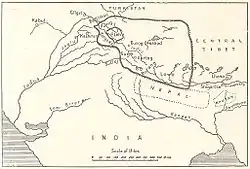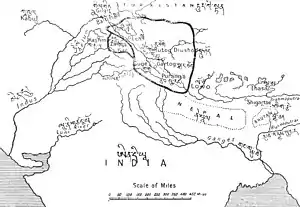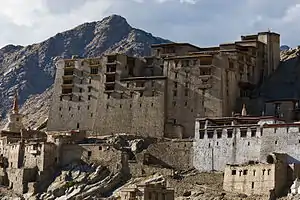Namgyal dynasty of Ladakh
The Namgyal dynasty was a line of rulers of a kingdom in modern-day Ladakh that lasted from 1460 to 1842. The Namgyal dynasty succeeded the first dynasty of Maryul and had several conflicts with the neighboring Mughal Empire and various dynasties of Tibet, including the Tibet–Ladakh–Mughal War. The dynasty eventually fell to the Sikh Empire and Dogras of Jammu and Kashmir. Most of its known history is written in the Ladakh Chronicles.
Namgyal dynasty of Ladakh | |||||||||||
|---|---|---|---|---|---|---|---|---|---|---|---|
| 1460–1842 | |||||||||||
 Historical map of Ladakh under at its largest extent | |||||||||||
| Capital | Leh | ||||||||||
| Common languages | Ladakhi, Tibetan | ||||||||||
| Religion | Tibetan Buddhism | ||||||||||
| Government | Monarchy | ||||||||||
| History | |||||||||||
• Established | 1460 | ||||||||||
• Disestablished | 1842 | ||||||||||
| |||||||||||
| Today part of | India (Ladakh) China Pakistan Nepal | ||||||||||
History
Founding
According to the Ladakh Chronicles, the Namgyal dynasty was founded by Bhagan, the son of Bhara in the kingdom of Maryul. Bhagan was described as warlike, and established the Namgyal dynasty in 1460 after he formed an alliance with the people of Leh and dethroned the Maryul king Blo-gros-mc-og-ldan and his brothers drun-pa A-li and Slab-bstan-dar-rgyas.[1]:25,171
He took the surname Namgyal (meaning victorious) and founded a new dynasty which still survives today. King Tashi Namgyal (1555-1575) managed to repel most Central Asian raiders, and built a royal fort on the top of the Namgyal Peak. Tsewang Namgyal temporarily extended his kingdom as far as Nepal.

Expansion
Sengge Namgyal (r. 1616-1642), known as the "Lion" King, made efforts to restore Ladakh to its old glory by an ambitious and energetic building program including the Leh Palace and the rebuilding of several gompas, the most famous of which are Hemis and Hanle.[2]
He expanded the kingdom into Zanskar and Spiti, but was defeated by the Mughals, who had already occupied Kashmir and Baltistan. His son Deldan Namgyal (1642-1694) had to placate the Mughal emperor Aurangzeb by building a mosque in Leh. However, he defeated the Mughal army in Baltistan. His son Delek sided with Bhutan in a religious dispute between Tibet and Bhutan, which resulted in an attempted invasion by the fifth Dalai Lama. The Moghuls withdrew after being paid off by the 5th Dalai Lama.[3] With the help of reinforcements from Galdan Boshugtu Khan, Khan of the Zungar Empire, the Tibetans attacked again in 1684. The Tibetans were victorious and concluded a treaty with Ladakh then they retreated back to Lhasa in December 1684. The Treaty of Temisgam in 1684 settled the dispute between Tibet and Ladakh, but its independence was seriously restricted.
Downfall
The Namgyal dynasty ended in 1842 after a surprise invasion of Ladakh from the Maharaja Ranjit Singh of Punjab.[4]
By the beginning of the 19th century, the Mughal empire had collapsed and Sikh rule had been established in Punjab and Kashmir. However the Dogra region of Jammu remained under its Rajput rulers (who ruled under the maharaja ranjit singh) Rajput ruler were given the control of their states but under the name of Punjab and they were part of khalsa empire, under the leadership of Maharaja Ranjit Singh (1792-1857)——his General Zorawar Singh invaded Ladakh in 1834. King Tshespal Namgyal was dethroned and exiled to Stok where they still had a small jagir until the post independence political integration of India.
List of kings
The kings of Namgyal dynasty along with their periods of reign are as follows:[5][6][7]
- Lhachen Bhagan (c. 1460-1485)
- Unknown (c. 1485-1510)
- Lata Jughdan (c. 1510-1535)
- Kunga Namgyal I (c. 1535-1555)
- Tashi Namgyal ('BKra‐śis‐rnam‐rgyal, c. 1555-1575) son[8]
- Tsewang Namgyal I (Ts'e-dbaṅ‐rnam‐rgyal, c. 1575-1595) nephew[9]
- Namgyal Gonpo (rNam-rgyal-mgon-po, c. 1595-1600) brother
- Jamyang Namgyal (Jams-dbyang-rnam-rgyal, c. 1595-1616) brother[10]
- Sengge Namgyal (Seng-ge-rnam-rgyal, first time, 1616–1623) son[11]
- Norbu Namgyal (1623–1624) brother
- Sengge Namgyal (second time, 1624–1642)
- Deldan Namgyal (Bde-ldan-rnam-rgyal, 1642-1694) son
- Delek Namgyal (Bde-legs-rnam-rgyal, c. 1680-1691) son
- Nyima Namgyal (Ñi-ma-rnam-rgyal, 1694-1729) son
- Deskyong Namgyal (Bde‐skyoṅ‐rnam‐rgyal, 1729–1739) son
- Phuntsog Namgyal (P'un‐ts'ogs‐rnam‐rgyal, 1739–1753) son
- Tsewang Namgyal II (Ts'e‐dbaṅ-rnam‐rgyal, 1753–1782) son
- Tseten Namgyal (Ts'e‐brtan‐rnam‐rgyal, 1782-1802) son
- Tsepal Dondup Namgyal (Ts'e‐dpal‐don‐grub‐rnam‐rgyal, 1802–1837, 1839–1840) brother
- Kunga Namgyal II (Kun‐dga'‐rnam‐rgyal, 1840–1842) grandson
Gallery
| Outline of South Asian history |
|---|
_without_national_boundaries.svg.png.webp) |
 Leh Palace
Leh Palace The Stok Royal Palace, residence of the Namgyal dynasty, former rulers of the former Ladakh kingdom, now Ladakh, Indian Union Territory
The Stok Royal Palace, residence of the Namgyal dynasty, former rulers of the former Ladakh kingdom, now Ladakh, Indian Union Territory
References
- Petech, Luciano (1977). The Kingdom of Ladakh, c. 950–1842 A.D. (PDF). Instituto Italiano Per il Medio ed Estremo Oriente – via academia.edu.
- Rizvi, Ladakh 1996, p. 69
- Johan Elverskog (6 June 2011). Buddhism and Islam on the Silk Road. University of Pennsylvania Press. pp. 223–. ISBN 978-0-8122-0531-2.
- Petech, The Kingdom of Ladakh, 1977 & 1, 138–170.
- Petech, The Kingdom of Ladakh 1977, pp. 171-172.
- Sali, M. L. (20 April 1998). India-China Border Dispute: A Case Study of the Eastern Sector. APH Publishing. ISBN 9788170249641. Retrieved 20 April 2018 – via Google Books.
- Kaul, H. N. (20 April 1998). Rediscovery of Ladakh. Indus Publishing. ISBN 9788173870866. Retrieved 20 April 2018 – via Google Books.
- Petech, The Kingdom of Ladakh 1977, pp. 28-29.
- Petech, The Kingdom of Ladakh 1977, pp. 31-32.
- Petech, The Kingdom of Ladakh 1977, pp. 33-37.
- Petech, The Kingdom of Ladakh 1977, pp. 38-56.
Bibliography
- Petech, Luciano (1977), The Kingdom of Ladakh, c. 950–1842 A.D. (PDF), Instituto Italiano Per il Medio ed Estremo Oriente – via academia.edu
- Rizvi, Janet (1996), Ladakh: Crossroads of High Asia (Second ed.), Delhi: Oxford University Press, ISBN 0-19-564546-4